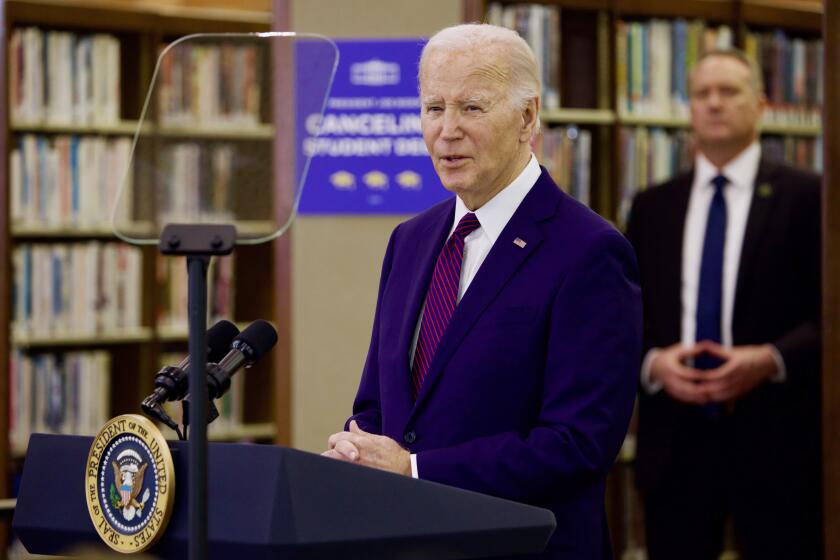Biden proposes new student-debt relief. Here’s who would benefit

- Share via
After months of hearings and negotiations, the Biden administration announced its latest plans Monday for student debt relief, proposing changes that would save about 30 million borrowers billions of dollars in total.
The plans aren’t as sweeping as the across-the-board loan forgiveness of up to $20,000 per borrower that President Biden ordered in 2022, a measure the Supreme Court threw out last year. But they go further than what the administration proposed in the wake of the justices’ ruling, offering to cancel all or part of the debt for borrowers for whom the loans pose a hardship.
The hardship proposal emerged in February, after a strong push from advocates of student-loan borrowers, said Natalia Abrams, president and founder of the Student Debt Crisis Center.
At this point, the administration’s plans are just that — the Education Department is expected to propose the new rules in the coming months, followed by a public comment period — before it can put the rules into effect. That’s when the legal challenges will probably begin, Abrams said, noting that the administration’s major efforts to ease student-loan debt have been challenged by conservatives.
That includes Biden’s Saving on a Valuable Education plan, which slashes the long-term cost of federal student loans for borrowers of limited means. Eleven Republican state attorneys general sued to block the plan in March, saying the administration did not have the legal authority to offer it.
Republicans say President Joe Biden’s plan to start canceling student loans for some borrowers in February is an attempt to win voters ahead of the 2024 presidential election.
On Monday the administration released an outline of its plans. The main features are:
- Debt cancellation for borrowers who’d been repaying their undergraduate loans for at least 20 years, or their graduate school loans for at least 25 years.
- Balance reductions for about 25 million borrowers whose debt grew because of unpaid interest. The plan would wipe out up to $20,000 in interest-related debt for all borrowers. Those who enrolled in income-driven repayment plans and saw their debt grow even if they made their required monthly payments would have all interest-related debt canceled automatically.
- Debt cancellation for borrowers eligible for loan forgiveness, but who had not applied. This group includes people enrolled in certain income-driven repayment plans and the Public Service Loan Forgiveness program.
- Debt cancellation for students at schools or programs that were declared ineligible for federal student aid programs because they “cheated or took advantage of students,” the Education Department said. Debt relief would also be available for students at schools or programs that closed and “failed to provide sufficient value — for example, that leave graduates with unaffordable loan payments or earnings no better than what someone with a high school diploma earns.” The outline released Monday offered no details on how eligibility would be determined.
- Partial or full debt cancellation for borrowers experiencing hardship in repaying their loans. A preliminary version of this proposal said it would apply not just to recipients of loans made directly by the federal government, but also to all Federal Family Education Loan recipients, including parents who took out Federal PLUS Loans through private lenders.
The rationale behind most of these proposals is that student loan programs were poorly managed and administered, causing borrowers to amass far more debt than they should have.
For example, the Education Department argues that many borrowers who were having trouble making payments were steered into forbearance, which increased their debt, rather than income-based plans that could ultimately reduce their burden.
“Many of these people, these borrowers, did pay [back] what they borrowed,” Abrams said. “What they’re dealing with is compound capitalized interest” — additional debt beyond the initial loans caused when unpaid interest is folded back into the loan balance. Essentially, borrowers pay interest on the interest. That happened even to borrowers enrolled in programs that tied their payments to their income, when monthly payments were not large enough to cover their interest charges.
The student debt announcement was Biden’s final event during a two-day swing in the Los Angeles area. He headlined a major fundraiser the previous night.
Once people understand how often these loan programs made matters worse for borrowers, Abrams said, they at least agree that the extra interest burdens should be wiped out. That’s what the administration’s new rule would do.
The Committee for a Responsible Federal Budget, which advocates for lower federal borrowing, blasted the plans in a statement Monday.
“The President’s previous student loan cancellation plan was expensive, inflationary, poorly targeted, and would have boosted rather than reduced tuitions,” said Maya MacGuineas, the group’s president. “This plan similarly misses the mark....
“The President has already spent more than $600 billion on debt cancellation — which is as much as the federal government is slated to spend on K-12 education for the next decade and more than double the cost of his budget’s proposal to offer free community college, expand Pell Grants, and increase other higher education funding. The White House should turn its attention to working with Congress to actually pass structural reforms that get to the root of the problem and are fully paid for.”
Abrams said advocates for borrowers “wanted full and complete debt cancellation,” which the new Biden plan would not deliver. Nevertheless, she said, “this is another huge step in the right direction.”
She added: “What [Biden] is doing is, he’s fixing the broken system.” That includes steps such as the SAVE plan, she said, in which the government covers unpaid interest for borrowers who remain current so their loan balances do not grow.
The plans unveiled Monday came after the Education Department sought to reach a consensus among borrowers, loan servicers and others involved in student loans on an approach to debt relief based on the Higher Education Act. Abrams said she believed the negotiators did reach consensus, but that didn’t bridge the political divide over loan forgiveness.
More to Read
Sign up for Essential California
The most important California stories and recommendations in your inbox every morning.
You may occasionally receive promotional content from the Los Angeles Times.













